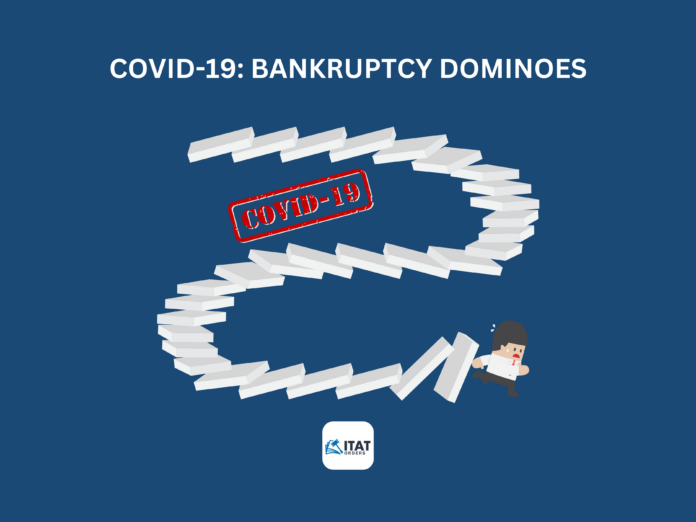As on 10th of May 2020, there are around 4.06 million reported cases of coronavirus confirmed all around the globe, costing humanity as many as 280’K lives. And, looking forward it looks like the virus isn’t going to spare companies either. Since the pandemic had brought the whole world and economies along with it to a standstill the companies and firms are having a hard time to keep their businesses afloat with no or very little cash flow and debts and liabilities piling up.
Companies have perpetual succession they usually enjoy a continuous existence whereas us human we have an end i.e. death, for companies that end is usually when they’re liquated voluntarily or when they’re forced into bankruptcy. Bankruptcy isn’t a death sentence. Bankruptcy is a legal process through which people or other entities who cannot repay debts to creditors may seek relief from some or all of their debts. In most jurisdictions, bankruptcy is imposed by court order, often initiated by the debtor.
Since major COVID-19 led bankruptcies are filed by US multi-national companies, we should have a brief idea about their Bankruptcy Code. In US a company can file for bankruptcy under six chapters under their Bankruptcy Code, however, the major ones are
- Chapter 7: basic liquidation for individuals and businesses; also known as straight bankruptcy; it is the simplest and quickest form of bankruptcy available
- Chapter 11: rehabilitation or reorganization, used primarily by business debtors, but sometimes by individuals with substantial debts and assets; known as corporate bankruptcy, it is a form of corporate financial reorganization which typically allows companies to continue to function while they follow debt repayment plans
- Chapter 13: rehabilitation with a payment plan for individuals with a regular source of income; enables individuals with regular income to develop a plan to repay all or part of their debts; also known as Wage Earner Bankruptcy
Major companies that have filed for (Chapter 11, not Chapter 7) bankruptcy include:
- J.Crew Group: The classic clothing brand J.Crew, the seller of sweater vests, chinos, is one of the first major retailers to seek bankruptcy protection in the U.S. According to its May 4 filing, the group which runs both J.Crew and Madewell will convert $1.65 billion of its debt into equity with lenders and has secured $400 million in “debtor-in-possession” financing, which lets companies stay operational while undergoing bankruptcy. However, the company expects to re-open 181 J.Crew stores, 171 J.Crew factory stores, and 140 Madewell stores after coronavirus restrictions are lifted.
- Gold’s Gym: The fitness center chain, which started in Venice Beach, California, filed for bankruptcy on May 4. The company closed its empire of roughly 700 gyms during the coronavirus pandemic, 30 of which will remain closed after the bankruptcy. However, the company will continue to reopen the rest of its gyms throughout the process, depending on federal, state, and local guidelines.
- Dean & Deluca: The luxury grocer was already hanging by a thread when it was heading into 2020, as it closed its founding, flagship store in Soho, New York, in October. In its April filing, which finally cited the coronavirus pandemic as a final straw, listed only one employee and $500 million in liabilities against $50 million in assets. However, the company still hopes to reopen Dean & Deluca locations in New York in the near future.
- True Religion: The company filed for bankruptcy in April for the second time in three years. While the brand was already navigating a slump, the government-ordered shutdowns of brick-and-mortar stores due to the coronavirus pandemic sent the company into bankruptcy once again.
- Speedcast International: is an Australian satellite internet company whose global maritime network serves 80% of cruise ships around the world filed for bankruptcy in April. The company referred to their weakness in the cruise market as the coronavirus pandemic has curbed recreation and leisure travel, which worsen the company’s $600-odd million in an old debt, rendering it “impossible” to grab equity lifelines. Now that the company have filed for bankruptcy the company will restructure, backed by $90 million in debtor-in-possession financing.
- Flybe: is a British airline that used to provide more than half of U.K. domestic flights outside of London, entered administration that is U.K. equivalent on bankruptcy proceedings on March 5. Most of Flybe’s flights had been cancelled and grounded as Europe which was quickly becoming the epicenter of the coronavirus pandemic. Since the company’s $128 million (100 million British pounds) aid request was denied by the U.K. government. Since the airline was already struggling and denial of aid in such times left the company with no option but to file for bankruptcy.
- Virgin Australia: one of Australia’s largest airlines co-founded by billionaire Richard Branson became the world’s largest carrier to file for bankruptcy through voluntary administration in Australia. The company’s plea for a $903 million (1.4 billion Australian dollars) loan from the Australian government was denied. The company haven’t had posted profits for the last 7 years prior to coronavirus pandemic, however, potential buyers believe it can survive with restructuring.


